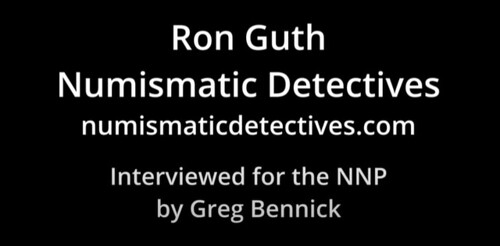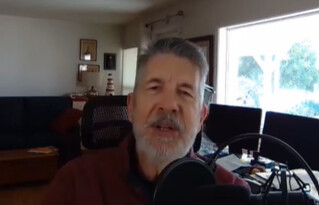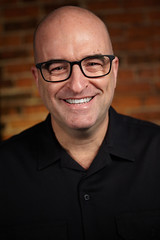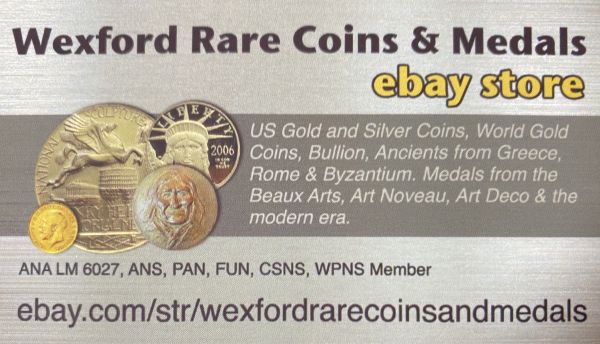
PREV ARTICLE
NEXT ARTICLE
FULL ISSUE
PREV FULL ISSUE
RON GUTH INTERVIEW, PART TWOGreg Bennick's latest interview for the Newman Numismatic Portal is with author, researcher and Numismatic Detective Ron Guth. Here's the second part, where Ron talks about becoming a numismatic writer and researcher. -Editor Greg Bennick: Very cool. So how did you start down the path of being a researcher and a writer? How did that come about? Ron Guth: I guess it came about when I started the auction company with Jeff Garrett in 1983 ish. Then, of course I became a cataloger and a photographer. Back then, there was no digital photography. So I actually took a course at Transylvania University to the really odd name in Lexington, Kentucky and I learned how to do photography. And I actually did the processing in our bathtub at home, which of course drove my wife crazy because I had pictures of coins all over the bathroom, but that's what you did. So I became a writer and then years later, I went to California, which is where I am now and I started working with Dana Linett at Early American History auctions. I started out as a numismatic cataloger for him, but then I got into historical documents, so basically, I became a writer. You know, people can describe things as basically just looking at a coin and saying what are the positives or the negatives? Of course, you try to play at the positives, but it's basically just putting into words what you see with your eyes. Greg Bennick: That makes a lot of sense, it really does. I'm just amazed at just the path and how one thing leads to another, leads to another, leads to another. So, in terms of the books that you've written now, is there any one in particular that you're most excited about? I know that The 100 Greatest US Coins is almost an institution in and of itself, but Jeff told the story, or at least hinted at the fact that The Encyclopedia of US Gold was quite an experience to create. Can you tell me a little bit about that?
So, learning how to write a book or being taught how to write a book by the Dummies people was probably the most important development in my writing career because then I learned what it takes to actually write a book. When I worked with Jeff on the 100 Greatest books, that was basically his idea. And we just picked a group of coins, more than a hundred, and then sent it to the PNG and they all voted. It was a popularity contest per se, and they decided which were going to be the one hundred greatest coins and then we wrote the stories about each one of them. Same thing with the one hundred greatest women that I wrote later on. In this case, I asked the women and Numismatics organization to select the top 100 out of the many hundreds that there were. The Encyclopedia of U.S. Gold Coins was a huge project because basically every U.S. gold coin, including major varieties. And that took a tremendous amount of research because we have to look at rarity of the coins, what conditions are available to collectors and then pricing. It was also tied into the Smithsonian because they had this fabulous collection of coins, including many coins that are not available anywhere else. So that was a really wonderful project, really time consuming. I think it took us about six months or longer just to do the writing for that book. Greg Bennick: Did you find that you and Jeff had different strengths, for example, like pricing seems to be his forte. Did you have different strengths that lended well to you working together on that? Ron Guth: Yeah, we complement each other really well. I don't know why it is, but I would read the part that he's written and then the part that I wrote and they're almost interchangeable. The styles of writing are incredibly alike, and I'll read the book and I'll say did I write that or did Jeff write that? You know? It's really interesting. Jeff's forte is pricing, of course, he's an incredible dealer and he's handled a lot of really great rare coins. So, he has that sort of man on the street knowledge. My forte is in the research. I can look up whatever data you need and put it into a narrative. So, we complement each other really well in that regard. Greg Bennick: Great. Now, in terms of the 100 Greatest Women, that book, what led you to want to write that? Meaning it's of course, so important, I couldn't believe that I don't have it in my library. I actually bought it last night, which tends to be a thread in these interviews, meaning I didn't have the latest edition of 100 Greatest U.S. Coins. And right before my interview with Jeff Garrett, I thought I really should have the latest edition. So last night I bought the 100 Greatest Women on Coins. What led you to want to write that? Meaning that women are so largely unrepresented oftentimes in the coin hobby. And I love the title of the book and what it's about. Can you tell me the why behind the book? Ron Guth: Sure. I went and worked on a master's degree, I think I got it in 2015, which is right before I started writing the book. And my favorite areas in the master's program were black history and women's history, you know, the struggle for women's rights to vote and that sort of thing. I had a wonderful teacher. It was an online course, and normally when you have an online course, you sign up and there's 15 other people in the class. And so, you have this cohort that you go along with. In this instance, I signed up for the course and the first day I met the professor, I said, Where's everybody else in the course? Only one person had signed up for it and I said, Well I'll leave it up to you professor. If you want to teach me one-on-one, that would be great, but if you don't, I totally understand it. She said no, let's do it. And what that meant was that in cases where I would normally be responding to someone else in my cohort, I was actually one-on-one with a teacher every day and I learned so much from her and it was just such an incredible course that I was just fascinated by the history of women in America. And then I started thinking about women on coins. And you're right, women are underrepresented in our hobby, but it turns out that they're not underrepresented on coins. I thought I might find 50 women on coins, maybe 75 or 100. It turned out when I surveyed everything, and this includes ancient coins up to modern, I got over 700 women. And I would think if I did the survey today, it'd probably be closer to 800 or even more. So that really blew my mind that there were that many different women on coins. And then I thought, well why don't I follow the concept of the one hundred greatest coins and do the one hundred greatest women? So that's how that evolved. Greg Bennick: That's fantastic. Amazing. So, let's talk about Coin Facts. How did that all come about and what was it like creating it? Ron Guth: Coin Facts was basically I wanted to take the information that I had about U.S. coins and make it available on the Internet, I called it the Internet Encyclopedia of U.S. Coins. I wanted to put technical data in. I wanted to put images of every coin because back then, the information that you could get would be the Red Book and there were other specialized books and that sort of thing. But there wasn't a place where you could take an entire library and dump it into one format that people could use. So, I developed Coin Facts, and that was a really wonderful, fun project. You know, today we have the Newman Numismatic Portal, which basically has destroyed the value of my library, unfortunately. But what that means is that I have access to all this information that twenty-five, or thirty years ago, you had to spend a lot of money to build a library. Today you don't. The information is readily available and free and it's wonderful. And so that's what I started doing in 1999 and then that grew. And PCGS Collector's Universe purchased it in 2004 and then they rolled it out further and now it's PCGS Coin Facts which is one of the great intangible values in their company. Greg Bennick: And just so we don't get protest emails from Charles Davis and other purveyors of numismatic literature, I'm going to throw in my vote. And I'm sure you'd agree. That even though much of our library material can be found online, there's still something to be said for holding a book in your hands, sitting under a lamp on the couch and reading the book. I absolutely support that. Ron Guth: You can't see it here, but I am surrounded by books. A lot of them are piled on the floor here, but when I do my research every day, there are certain go-to books that I have to have the physical book. I use the Newman Numismatic Portal all the time. But you're right, there are certain books that you have to have and have to keep. Greg Bennick: And there's also things, of course, that aren't on the NNP that you're not going to find anywhere. I mean, the other room is filled with things related to the error hobby and ephemera and this person's badges from an A&A meeting in 1969 and all this weird stuff that I've collected that I think that those things are really great to hold in hand and any book as well, so that's fun to think about. So, the Numismatic Detective Agency, I'm just fascinated by the name and the mission and what you do in terms of exploring the provenance on high end coins. But can you tell us about that and then the other services you provide and how that all came about? Ron Guth: Sure. The Numismatic Detective Agency came about because it's what I do. I am constantly looking for old provenance, you know, matching coins from today back to old auction catalogs, you know, comparing images and matching images. So, it's really detective work. I'm trying to find coins from fifty or one hundred years ago and reattaching them to the coins today. Coin Facts started as an image library. If you can't have the physical coin, the next best thing is an image. And fortunately, today especially, the digital images are so good that you can actually match them up with images from 100 years ago. In fact, some of the photography from the early 1900's and late 1800's even is better than the photography that was done in say the 1940's and 1950's. So, the detecting part of it is much easier today because of these great images we have. I have a huge database of 60 or 70,000 images of the top ten coins of everything. I do patterns, colonials, varieties, you name it. I'm always taking the image and I call it like pin the tail on the donkey because I can take whatever data it is, a grade and attach it to a coin, a provenance, and attach it to a coin, so I'm basically pinning tails to this coin all the time. And it is a lifelong project because I've been working on it for many years and I still see no light at the end of the tunnel, but it's an extremely enjoyable process.
To watch the complete video, see:
To read the complete transcript, see:
To read the earlier E-Sylum articles, see:
Wayne Homren, Editor The Numismatic Bibliomania Society is a non-profit organization promoting numismatic literature. See our web site at coinbooks.org. To submit items for publication in The E-Sylum, write to the Editor at this address: whomren@gmail.com To subscribe go to: https://my.binhost.com/lists/listinfo/esylum All Rights Reserved. NBS Home Page Contact the NBS webmaster 
|




